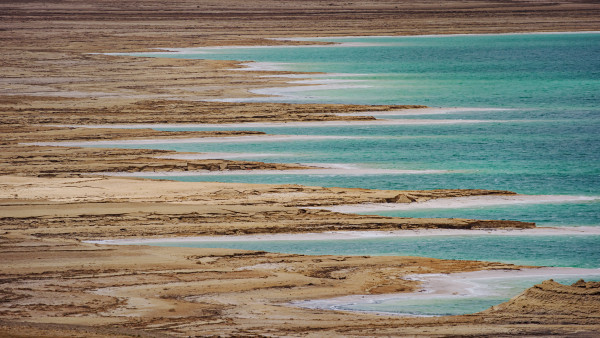Water security has become a national matter in the MENA region where 12 of the 17 most water-stressed countries in the world are located. So what strategies are being employed by the GCC states to counter this threat?
Globally, nearly four billion people are living in water-stressed areas while over one billion are facing extreme water scarcity. As disruptive weather patterns are setting in more regularly due to climate change, water availability is getting even more difficult.
The World Economic Forum has highlighted the ‘failure to act on climate change’ as the second-highest risk after infectious diseases in its 2021 Global Risk Report.
Currently, the Middle East and North Africa (MENA) countries are badly struck by water scarcity and are being rated as one of the most vulnerable zones. Having a low precipitation level along with rapid urbanisation and a rapid rate of desertification and frequent drought, 12 of the 17 most water-stressed countries worldwide are now located in the Middle East.
Predicting a growth rate decline of six percent in the global GDP due to water scarcity by 2050, the World Bank has specified it as a major risk. Having only two percent wetlands, the Middle East and North Africa region’s limited reserves cannot cope once climate changes set in.
12 of the 17 most water-stressed countries worldwide are now located in the Middle East
According to the latest National Intelligence Council report named Global Trends: Paradox of Progress, “More than 30 countries – nearly half of them in the Middle East – will experience extremely high water stress by 2035, increasing economic, social, and political tensions.”
And in the “Aqueduct Water Risk Atlas” rankings prepared by the Washington-based World Resources Institute (WRI) in 2019, Qatar was placed first, followed by Israel, Lebanon, Iran, Jordan, Libya, Kuwait, Saudi Arabia, the UAE, Bahrain and Oman in descending order.
Mainly, these are the risks allied with water scarcity.
First, impacting both agricultural and non-agricultural activities, water scarcity and changes in crop yields could affect food security.
Discussing this issue with The New Arab, Professor Michaël Tanchum, senior fellow at the Austrian Institute of European and Security Policy and non-resident fellow at the Middle East Institute in Washington, D.C., stated that, “Extreme water stress is becoming an increasingly urgent problem for the MENA region and adjacent areas.
“Fundamental for food production and human consumption and hygiene, water scarcity pressures can be heightened when there are competing demands from critical economic sectors such as hydro-electric power generation and the production of water-intensive, cash-earning crops such as cotton – conditions we see in Egypt and Ethiopia.”
“Extreme water stress is becoming an increasingly urgent problem for the MENA region and adjacent areas”
Second, water scarcity is bad for Middle Eastern economies as it can drive down their GDPs significantly with dwindling crop yields. According to the World Bank, the MENA region could have the highest economic losses just due to climate change induced water scarcity, and the estimates are 6-14 percent of the GDP by 2050.
As per a study conducted by the World Bank in 2020, this joint impact could decrease the GDP of “Iran, Iraq, Jordan, Lebanon, Syria, Turkey, up to 7.2 percent, 3.9 percent, 6.8 percent, 1.9 percent, 9.8 percent, and 5.9 percent, respectively; and the Rest of the Middle East (RME) by up to 4.1 percent.”
Third, according to the UNHCR, extreme weather events usually set off mass migration and domino-like dislocations. Living in climate hotspots with limited resources and water scarcity, people may become IDPs (internally displaced people) and simply start moving in search of water and other basic needs. When the environment gets increasingly hostile, this creates a ‘domino effect’ and gives them little space to recover. People at the frontlines of disaster may even become ‘stateless.’
Ostensibly, rural migration to cities in a region which already has more than half of its population living in urban areas can become a serious issue. And it does not end there, as increasing pressures on limited supplies can cause even more migration and it becomes a vicious circle.
It has been estimated that 150 to 200 million people may become displaced due to climate related issues by the year 2060, and water scarcity will be the major cause. In fact, two major migration tracks could run through MENA and South Asia according to research by the Institute of Economics and Peace.
It has been estimated that 150 to 200 million people may become displaced due to climate related issues by the year 2060, and water scarcity will be the major cause
Third, in extreme conditions, deteriorating water security can even cause wars and serious conflict. As Professor Tanchum told The New Arab, “Such conditions, whether by scarcity or denial of access, can quickly spark cross-border military conflict as we saw with the 2014 clashes between the Kyrgyz and Tajik militaries as well as the 2016 border conflict between Kyrgyzstan and Uzbekistan. The possibility of escalation between Egypt and Ethiopia cannot be ruled out.”
In a report prepared by the Arab Strategy Forum in Dubai and the Good Judgement, a geo-economic and geopolitical forecasting entity, water scarcity is specified as a security risk for the MENA region.
Describing water scarcity as a “contributing factor in the escalation of hostilities” in the region, this report predicts the chances of a conflict between Jordan and Israel as just one percent. However, Turkey and Iraq or Egypt and Ethiopia had higher risk of conflict at three percent.
At the very least, water insecurities can cause civil unrest. In the past, Iraq and Iran have faced water-riots while even the Arab Spring revolt has been linked to droughts and heatwaves.
According to Waleed Zubari, coordinator of a water resources management programme at the College of Graduate Studies in Manama, Bahrain, around one million people were affected by drought conditions in Syria from 2006 to 2009.
In his opinion, “Water is increasingly becoming an additional source of tension in an already unstable region.” Consequently, water has now become a national security priority for most Arab nations.
In the current circumstances, what immediate steps can MENA countries take to boost water security?
For starters, nearly 82 percent of the region’s wastewater is not re-used enough and doing this may decrease water deficit. It is time to stop thinking of used water as dirty, once recycled it should be readily accepted as a “new” water source.
Next, more investments are required to boost agricultural efficiency so that water is not wasted. With techniques like precision watering and better seeds, less water would be required.
Also, building grey infrastructures like pipes and treatment plants alongside green additions like watersheds and wetlands can help improve both the water quality and supply, according to WRI and World Bank research.
And finally, almost 60 percent of the Middle East’s surface water is originally from areas outside the region and the equitable distribution of these supplies can help improve the situation.
Even though the risk ratio is low right now and the immediate impact would be just economic or limited to street protests or rural migration to cities, there is urgent need to incorporate water security and hydro-diplomacy in government long-term planning before the problem multiplies.
By: Sabena Siddiqui – a foreign affairs journalist, lawyer and geopolitical analyst specialising in modern China, the Belt and Road Initiative, Middle East and South Asia.
Follow her on Twitter: @sabena_siddiqi
Source: the New Arab
***Show us some LOVE by sharing it!***



